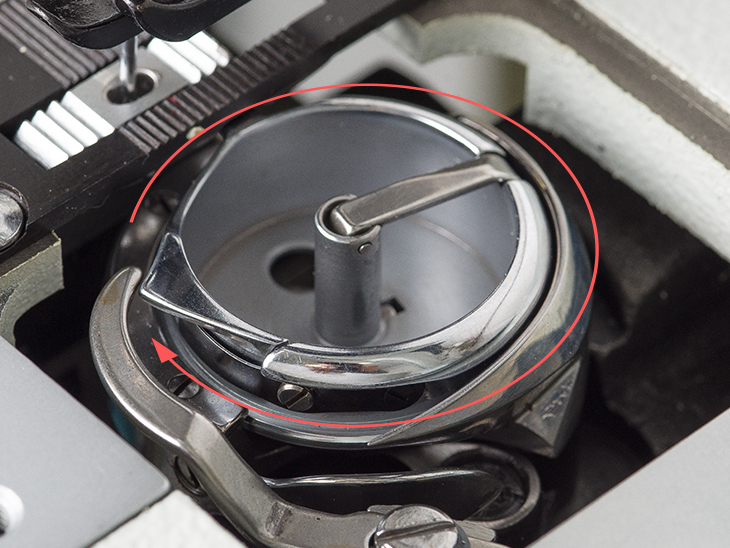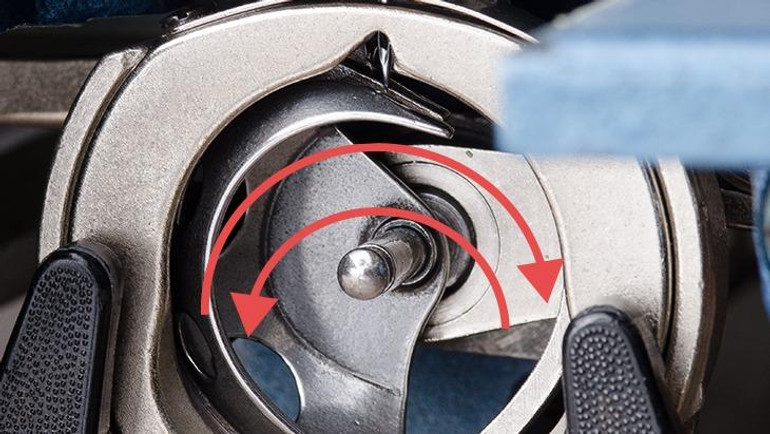A rotary hook and a shuttle hook are two different types of hook systems used in sewing machines.
Whether you're shopping for a new sewing machine or just looking to better understand the one you have, it can be helpful to understand the differences in features and functionality between machines. One feature that plays a key role in how your sewing machine works is the hook system. This is the part of the machine that catches the thread as it is forced out of the needle to create a stitch. There are two main types of hooks, rotary and oscillating. Both hooks create lockstitch stitches, but they work differently and have a couple of different considerations. Let’s take a closer look at these two systems.
Rotary Hook Machines
A rotary hook is a type of hook that rotates in a continuous circular motion, typically located in the lower part of the sewing machine right underneath the needle.

Caption: Rotary hook without the bobbin.
A rotary hook machine, sometimes called a full rotary machine, is a machine in which the hook rotates in a full circle around a stationary bobbin. In this system, the shuttle hook catches the thread when the needle is going back up through the fabric and the hook then carries the thread around the bobbin cage to form the stitch, going all the way around the bobbin.
Rotary machines use a gear or timing belt linkage between the top and bottom shafts of the machine. To keep this function working properly, it must be set very precisely. This need for precision means that rotary hook sewing machines have tight thread tolerances. In other words, they work well with threads of specific, recommended sizes but can be unforgiving outside of their range.
Additionally, small rotary hook machines tend to need their timing adjusted more frequently to maintain that precision. A sewing machine with a rotary hook runs smoother at higher speeds (no vibrating), is quieter and has less frequent thread jams than machines with shuttle hooks. Rotary hooks are the standard choice for industrial sewing machines.
Shuttle Hook Machines

Caption: Shuttle Hook Sewing Machine, Example: JUKI TNU-243U
Shuttle hook sewing machines, also known as oscillating hook sewing machines, have a hook that, instead of rotating in a full circle, oscillates back and forth. In this system, the hook picks up the upper thread from the needle and carries it down around the bottom of the bobbin cage. Once it has done this, the hook reverses its direction and returns to its original location.
Shuttle hook sewing machines have simpler mechanics than rotary hook machines. They are also easier to time and maintain. Since oscillating hook machines have looser tolerances than the precise rotary hooks, oscillating hook machines can sew heavier threads in smaller machines. The drawbacks to oscillating hook machines are that they are louder, they vibrate more and are generally not as fast, however they are the most suitable for extra heavy duty applications that's why the majority of extra-heavy duty sewing machines such as the JUKI TBU-243U, the Habraken HM866 and others use the shuttle hook system.
If you’re looking at purchasing a new machine, the shuttle type is often listed in the machine’s specifications. If you’re unsure what type of hook your current machine has, there’s a simple way to tell. Remove the bobbin from your machine and turn the balance wheel by hand. Watch the motion of the hook. Does it make a full circle or does it change directions? If it changes direction, it’s an oscillating hook and if it stays on a full circular pattern it’s a rotary hook.
In summary, rotary hook and shuttle hook are two different types of hook systems used in sewing machines. Rotary hook systems are faster, more precise, and less likely to jam, while shuttle hook systems are simpler, easier to time, but also capable of handling extremely heavy duty applications. The type of hook system you choose will depend on the specific requirements of your sewing project, and the type of machine that best suit your needs.


